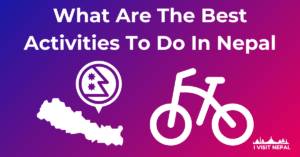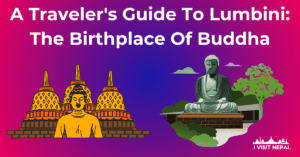The Ultimate Guide to Visiting Nepal: Plan Your Perfect Trip
Introduction: Why Visit Nepal?
Nepal is a country like no other—a land where ancient traditions coexist with breathtaking natural beauty. Whether you’re an adrenaline junkie looking for your next big adventure or a culture enthusiast eager to explore centuries-old temples and festivals, Nepal has something for every traveler. With the towering Himalayas as a backdrop, Nepal’s landscapes are as diverse as its culture, ranging from lush lowland jungles to snow-capped peaks.
In this guide, we’ll explore how you can tailor your trip based on your travel goals, whether you’re staying for just a few days or planning an extended journey.
Overview of Nepal’s Unique Attractions
Nepal offers a wide variety of unique attractions, making it a must-visit destination for many types of travelers:
- The Himalayas: Known for its towering peaks, including Mount Everest, Nepal is a paradise for trekking enthusiasts.
- Cultural Heritage: The Kathmandu Valley alone is home to seven UNESCO World Heritage Sites, including temples, palaces, and ancient towns.
- Wildlife: Nepal is also rich in biodiversity, with several national parks that offer wildlife safaris where you can spot rare species like the Bengal tiger and one-horned rhinoceros.
Cultural and Natural Diversity
Nepal’s unique blend of cultural and natural diversity makes it appealing to both adventure seekers and those looking to immerse themselves in local traditions. You’ll find:
- Hindu and Buddhist traditions: Ancient temples, stupas, and festivals that reflect Nepal’s religious heritage.
- Mountainous and tropical climates: Whether you’re exploring the lowland Terai or the alpine Himalayas, the landscapes shift dramatically within a short distance.
Personalized Experiences for Different Types of Travelers
Nepal is an excellent destination for travelers with varied interests:
- Adventure travelers: Known for its world-class trekking, rafting, and mountaineering.
- Cultural enthusiasts: Nepal’s rich traditions and festivals offer a deep dive into local life.
- Nature lovers: Safaris, birdwatching, and conservation tours await those interested in the country’s wildlife.
Determining Your Travel Objectives
Before booking your trip, it’s important to define what kind of experience you want. Nepal offers a diverse range of activities, so it’s helpful to prioritize based on your personal travel objectives.
Adventure Tourism (Trekking, Rafting)
If you’re an adventure enthusiast, Nepal offers some of the best trekking routes in the world, including the Everest Base Camp and Annapurna Circuit. Other activities like white-water rafting, paragliding, and bungee jumping are also popular.
Cultural Exploration (Temples, Local Festivals)
For those more interested in culture, Nepal has an abundance of ancient temples, stupas, and monuments. The Durbar Squares of Kathmandu, Patan, and Bhaktapur are essential stops for their rich history and intricate architecture. Festivals like Dashain, Tihar, and the Buddha Jayanti celebrations provide an immersive cultural experience.
Nature and Wildlife (National Parks, Conservation Areas)
Nepal is home to a wealth of biodiversity, particularly in its national parks. Visit Chitwan National Park for a chance to see Bengal tigers and one-horned rhinoceroses or head to Bardia National Park for an off-the-beaten-path wildlife experience. Nepal is also a fantastic destination for birdwatchers.
Short Stays (3-5 Days)
If you’re planning a short visit to Nepal, you’ll want to focus on getting the most out of your time, particularly in the Kathmandu Valley.
Sample Itinerary for Short Visits
- Day 1: Arrive in Kathmandu and explore the historic Durbar Square.
- Day 2: Visit Swayambhunath (Monkey Temple) and Pashupatinath Temple.
- Day 3: Take a day trip to Bhaktapur and Patan for a deep dive into Newari culture.
- Day 4: Visit Boudhanath Stupa and enjoy the bustling Thamel neighborhood.
- Day 5: Optional scenic flight around Mount Everest or a short trek around the Kathmandu Valley.
Must-See Attractions in Kathmandu Valley
The Kathmandu Valley is a UNESCO World Heritage site and offers a concentration of Nepal’s most iconic landmarks:
- Pashupatinath Temple: One of the holiest Hindu temples in the world.
- Boudhanath Stupa: One of the largest stupas globally and a major pilgrimage site for Buddhists.
- Swayambhunath: Also known as the Monkey Temple, it offers panoramic views of the city.
Quick Cultural Immersion Experiences
Even on a short trip, you can immerse yourself in local culture:
- Attend a traditional Newari dinner in Bhaktapur or Kathmandu.
- Watch a Nepali folk dance performance in the evening.
- Visit a local artisan market for unique handmade goods.
Moderate Stays (6-10 Days)
For those staying a bit longer, you can balance adventure with cultural experiences while exploring beyond the Kathmandu Valley.
Balanced Itinerary with Major Highlights
- Days 1-3: Explore Kathmandu and its surrounding heritage sites.
- Days 4-6: Take a scenic drive or flight to Pokhara, the gateway to the Annapurna region. Enjoy boating on Phewa Lake and visiting the World Peace Pagoda.
- Days 7-10: Embark on a short trek in the Annapurna region, such as the Poon Hill Trek or Ghorepani Trek, which offer stunning views without the need for extensive trekking experience.
Popular Trekking and Adventure Options
For moderate stays, consider treks like:
- Ghorepani Poon Hill Trek: A 4-5 day trek that offers stunning panoramic views of the Annapurna range.
- Short Annapurna Base Camp Trek: A condensed version of the full Annapurna trek for those with limited time.
Suggested Cultural Sites and Activities
While in Pokhara, you can:
- Visit the International Mountain Museum.
- Explore Davis Falls and the Gupteshwor Cave.
- Experience paragliding or zip-lining over the valley.
Extended Stays (10+ Days)
For those lucky enough to stay longer, Nepal offers limitless opportunities for deeper exploration, whether you’re looking for intense trekking or cultural immersion.
In-Depth Exploration Itineraries
- Days 1-4: Explore the Kathmandu Valley.
- Days 5-9: Head to Everest Base Camp or embark on the Annapurna Circuit, with trekking options lasting from 10 to 20 days.
- Days 10-12: Visit Lumbini, the birthplace of Buddha, or head to Chitwan National Park for a safari experience.
- Days 13-15: Explore rural Nepal by staying in local homestays in villages like Bandipur or Tansen.
Comprehensive Trekking Routes (Everest Base Camp, Annapurna)
- Everest Base Camp Trek: One of the most famous treks in the world, offering views of the world’s tallest peak. This trek generally takes 12-14 days.
- Annapurna Circuit Trek: This 17-21 day trek offers a mix of incredible landscapes, from tropical valleys to high-altitude deserts.
Cultural and Rural Immersion Experiences
- Stay in a homestay for a true taste of rural life.
- Attend local festivals or participate in community events.
- Learn about traditional crafts like Thangka painting or pottery making.
Specialized Travel Plans
Some travelers may wish to customize their Nepal journey around specific interests like yoga, wellness, or volunteering.
Customizing Your Journey (Yoga Retreats, Volunteering)
Nepal offers a variety of yoga retreats nestled in the mountains, perfect for those seeking mindfulness and relaxation. Alternatively, many visitors choose to volunteer with local organizations focused on education, healthcare, and conservation.
Seasonal Travel Considerations
Nepal experiences different seasons that affect travel plans:
- Autumn (September to November): The best trekking season with clear skies and mild temperatures.
- Spring (March to May): Great for trekking and seeing rhododendron blooms.
- Winter (December to February): Colder, but still a good time to visit lower altitudes or indulge in cultural activities.
- Monsoon (June to August): Rainy, but ideal for jungle safaris in places like Chitwan National Park.
Festivals and Events
Traveling during major festivals like Dashain or Tihar can give you an immersive cultural experience. These are times when local traditions and family gatherings take center stage, offering travelers a unique insight into Nepalese culture.
Budgeting Your Trip
Nepal is a budget-friendly destination, but it’s still essential to plan your finances depending on the length and type of trip you’re planning.
Budgeting Tips for Different Durations
- Short stays (3-5 days): Expect to spend around $30-$50 per day for food, accommodation, and transport.
- Moderate stays (6-10 days): A budget of $50-$70 per day should cover basic needs and some adventure activities.
- Extended stays (10+ days): You can budget $20-$40 per day for longer stays, especially in rural areas.
Average Daily
Costs
On average, travelers can expect daily expenses in Nepal to break down as:
- Accommodation: $10-$50 per night depending on comfort level.
- Meals: $3-$10 per meal.
- Transport: $5-$15 for local taxis or buses.
Saving Money While Traveling in Nepal
- Stay in local guesthouses or homestays.
- Eat at local restaurants rather than tourist spots.
- Book treks through local agencies to avoid hefty middleman fees.
Travel Logistics
Understanding the logistics of traveling in Nepal will make your trip smoother and more enjoyable.
Best Time to Visit Nepal
The best time to visit Nepal is during the autumn (September to November) and spring (March to May) seasons, when the weather is clear and ideal for trekking.
Visa and Permit Requirements
Most travelers can obtain a visa on arrival at Kathmandu’s Tribhuvan International Airport. If you’re trekking in specific areas, such as Annapurna or Everest, you’ll need additional permits like the TIMS card and conservation area permits.
Transportation and Accommodation Options
- Transport: Public buses, private taxis, and tourist buses are common ways to get around. Domestic flights are available for reaching more remote areas.
- Accommodation: Ranges from budget guesthouses to luxury hotels and eco-resorts.
Conclusion: Making the Most of Your Trip
Nepal offers an unforgettable travel experience, whether you’re coming for a short visit or a long, immersive journey. To make the most of your trip:
- Plan ahead by defining your travel objectives and budget.
- Use local resources and guides to get the most out of your visit.
- Practice responsible tourism by respecting local customs, conserving the environment, and contributing positively to the local economy.
With this guide, you’re now ready to embark on a memorable adventure in Nepal. Happy travels!



